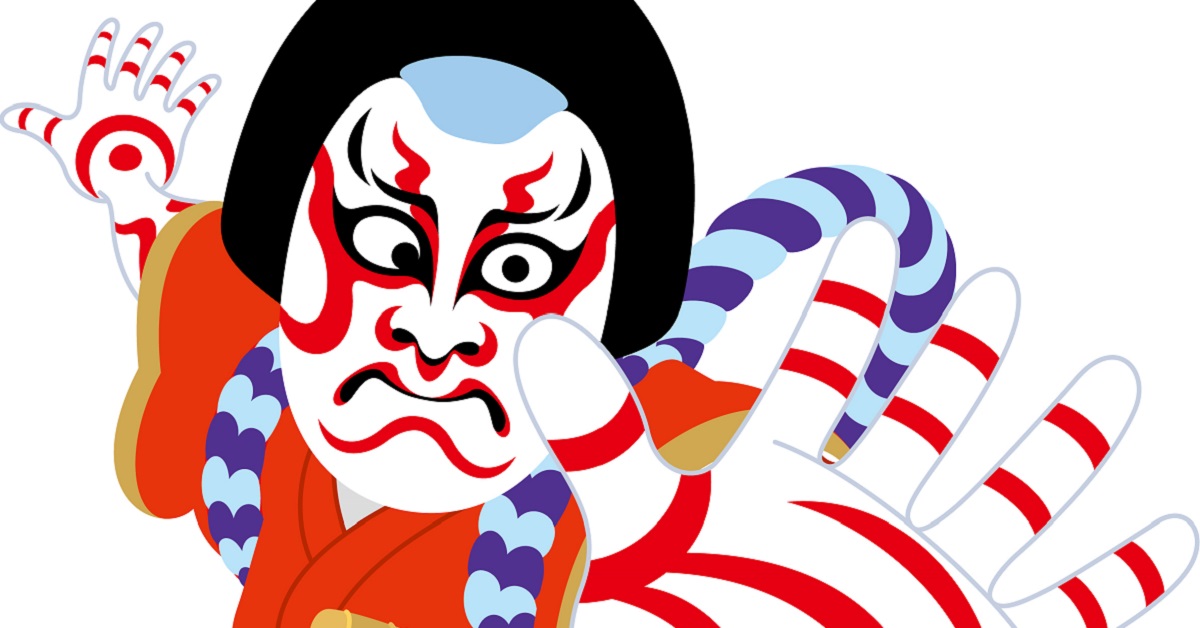In Kabuki, actors sometimes stop abruptly, striking a dramatic pose with an intense gaze. This is called Mie. It is not just a pose but a symbolic performance technique that highlights the climax of emotions and the essence of the story. Understanding Mie allows audiences, even those unfamiliar with Japanese, to experience the unique spirit of Kabuki.
What is Mie
In Kabuki, Mie (みえ) is a performance technique where the actor freezes in place to leave a strong impression on the audience. The direction of the face, the posture of the body, and the piercing gaze come together to create a powerful moment of stillness. At that instant, the audience holds their breath and shares the actor’s emotions.
Mie is not simply a matter of acting skill but a technique to condense and convey the climax of the story or the character’s inner emotions. Combined with voice and dialogue, it creates a powerful impression through both sight and sound.
Types of Mie
There are multiple types of Mie, each suited for different roles or scenes. The table below shows some representative examples.
| Name of Mie | Features | Scene Used |
|---|---|---|
| Ishi-nage Mie (Stone-throwing Mie) | The face swings strongly side to side, shooting a sharp gaze | Battle or confrontation scenes |
| Nirami Mie (Glare Mie) | Eyes open wide to overwhelm the audience | Scenes of anger or bravery |
| Hikkomi Mie (Exit Mie) | Performed just before leaving the stage | Leaves an aftertaste |
| Nimaime Mie (Handsome Mie) | Posture is graceful, highlighting beauty | Romantic or sensual scenes |
These are just examples, and different forms arise depending on the actor and the play. What audiences enjoy is this variety and the actor’s creativity.
Differences Between Mie and Other Theatrical Expressions
Mie is unique to Kabuki, but similar techniques exist in other forms of theater worldwide. Here is a comparison.
| Theater Form | Expression Method | Purpose |
|---|---|---|
| Kabuki | Mie, freezing movement to impress the audience | Emphasizing emotion, scene transitions |
| Noh | Frequent use of stillness and slow forms | Conveying spirituality and subtlety |
| Western Theater | Soliloquy or gesture to show emotions | Explaining feelings, directly appealing to the audience |
| Film | Close-ups emphasizing facial expressions | Visual emphasis on emotions |
From this comparison, it is clear that Mie is a uniquely Japanese stage effect that unites the actor and the audience.
History and Background
Mie originated in the Edo period. The first Ichikawa Danjūrō incorporated it into the aragoto (rough style) of performance, and it became a major feature of Kabuki. Townspeople of Edo loved the intensity of the stage, and whenever a Mie was performed, they shouted “Mattemashita!” (“We’ve been waiting for this!”) to cheer. This tradition continues today.
Furthermore, Mie is an element that creates unity between the audience and the actors. The audience’s shouts serve as great encouragement to the actors and enhance the power of their performance. The strong connection between the stage and the audience is what makes Mie so fascinating.
Scenes Where Mie is Often Used and Their Meanings
Mie is not performed randomly but placed effectively according to the development of the story. The following table shows typical scenes and their meanings.
| Scene | Role of Mie | Audience Impression |
|---|---|---|
| Confrontation with an enemy | Demonstration of strength and courage | Heightened sense of tension in the fight |
| Romantic scene | Emphasizing beauty and passion | Audience feels elegance and affection |
| Tragic moment | Condensed despair or anger | Deeper understanding of the character’s emotions |
| Just before exit | Leaves an aftertaste | Smooth transition in the flow of the play |
Thus, Mie functions as a device to imprint the scene on the audience.
How to Enjoy Mie
For foreigners watching Kabuki for the first time, Mie is an easily understandable highlight. Even without understanding the language, one can feel the flow of the story from the actor’s gaze, movements, and the audience’s reactions.
Here are key points for enjoying it:
- Focus on the actor’s eyes
In the moment of Mie, the actor’s eyes strongly express emotions. Through them, one can read anger, love, or determination. - Enjoy the audience’s shouts
Shouts such as “Naritaya!” are calls of the actor’s stage family name, and they enhance the atmosphere of the stage. - Feel the contrast in movement
Shifting from vigorous motion to sudden stillness highlights the dramatic tension of the stage.
The Meaning of Mie in the Modern Era
Even today, Mie plays an important role in Kabuki. It fascinates audiences overseas as well, being an expression that transcends language barriers. In digital streaming and filmed performances, Mie leaves a strong impression and helps spread traditional performing arts.
Modern audiences often encounter Kabuki through smartphones and videos, but the impact of experiencing Mie live is unmatched. The atmosphere becomes tense, and everyone in the theater concentrates on that single moment. This unique experience is unlike any other art form.
Conclusion
Mie is a distinctive Kabuki technique where the actor’s skill and the audience’s response fuse into a single moment. By knowing its history and understanding the meaning in different scenes, one can appreciate its depth and fascination even more.
When attending a Kabuki performance, pay attention to the moments when the actor freezes and delivers a strong impression to the audience. Mie is both an art form and a shared moment of connection between the actor and the audience on stage.






